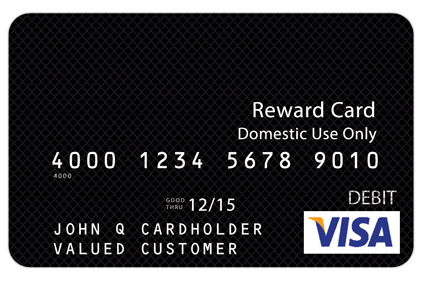In a 2012 InteliSpend study, 60% of companies using gift cards favor them for ease of administration, 59% cite broad audience appeal, 52% for redemption and flexibility, and 48% appreciate a gift card’s perceived value over cash rewards. In fact, the 2012 IRF study found that more than 75% of gift card program owners believe they “are among the most effective of all rewards – especially in driving loyalty and engagement.”
Gift card recipients, the study noted, echo these sentiments as well. The largest share of respondents – 44% – say gift cards, not cash, are their favorite award type. They appreciate the redemption flexibility gift cards offer: the ability to redeem them in a brick-and-mortar store, at an online retail site, or via a phone order. Recipients find gift cards have greater and longer-lasting impact than cash rewards. More than 79% of the 2012 IRF-IGCC study recipients said they remembered what they spent their gift card on, and the same amount linked that positive memory of the gift back to the people or company that awarded it.
In addition, electronic gift cards are increasingly popular. Through codes delivered via e-mail and mobile devices, they allow for immediate rewards, offer a variety of redemption choices for issuers as well as recipients, and are an environmentally friendly way to deliver awards.
With gift cards favored by givers and recipients alike, it would appear that using them for employee incentive would be a relatively easy undertaking. Not really, incentive experts say. The keys to administering a successful program include outlining the objectives and desired outcomes, planning the program itself, including card selection, branding and personalization, and the presentation itself. Putting these elements together in a coordinated fashion can help ensure successful results. Let’s examine some common pitfalls associated with uncoordinated programs and ways to improve the overall experience.
Avoid the mall
Sending employees to purchase gift cards at retail locations or “card malls,” while appearing on the surface to be an easy purchase decision, can actually cost a company more than it may realize.
A 2011 study at the University of California – Irvine found that once interrupted, it takes workers an average of 25 minutes to return to their original task. This doesn’t take into account travel time, time spent at the store shopping for cards, standing in line, or any additional errands tacked on.
Experts say using a third party to purchase gift cards allows easy tracking of what was purchased, the employee who made the purchase, and what the gift cards were used for.
And, while it takes only a minute or two to activate a single gift card at a retailer’s point of sale (POS) terminal, the task multiplicity of activating and verifying a large quantity of cards (not to mention dealing with various denominations within the purchase) takes much longer, and could be prone to error.
Smart incentive gift card shoppers should steer clear of retail outlets, and look to a business-to-business (B2B) gift card provider. According to Sales and Marketing Management Magazine (July, 2013), “you get client support, fulfillment services, budget control, cardholder support, and more.”
In addition, Matt Harris, past IRF chairman says, “the price is usually better for you because the participating merchants offset some of the cost. You also get to strategically build the list of merchants where your card can or can’t be spent so that the experience aligns with your objectives.”
Choosing a card
Gift cards are offered by major retailers, banks, catalog merchants and specialty stores of almost every type imaginable, including leading and luxury brands, which enhances the perceived value. The program administrator can choose cards carefully in order to target awards based on employee and/or customer demographics, or to communicate a particular program theme.
The IGCC, in a 2011 study, suggests that “aligning your incentive or premium program with leading industry brands…can significantly increase participation in the program you offer. Brand awareness is a major factor in the end users’ shopping experience, and by offering gift cards for brands they already recognize and are currently shopping for, you add awareness to your program – which leads to greater participation…The benefits of offering leading brands are very compelling.”
However, the IGCC report offers one cautionary note: The use of such cards needs to be appropriate to the program or the situation. Awarding a high-end card with a low denomination value “might end up being a de-motivator.”
Customization creates excitement
Customization is a valuable service offered by B2B card providers. Card faces can be customized with a company’s logo or program theme to help more actively engage recipients. For companies that use stored-value cards, in which points or cash value is added, customized cards become a point of pride for the recipient every time the card is used.
Kickoff and ongoing communication
As with any type of incentive or recognition program, it’s vital to provide high-impact kickoff, ongoing communication vehicles, and activities to build excitement and keep interest high. A comprehensive communications program should have a theme, incorporating the customization elements discussed earlier, and full explanation of the program – goals, objectives, measurements, and the way gift cards will be awarded and delivered. Program administrators should also provide printed and/or online material with program information and regular progress reports, and gather and communicate recipient feedback with gift card rewards choices, and what types of merchandise was purchased.
It’s all in the presentation
No successful gift card program is complete without paying special attention to the way gift card rewards are delivered and presented.
The IGCC suggests a number of effective ways to make gift card presentations a happy and memorable event. If cards are to be delivered, include with it a customized carrier with a handwritten, personalized note of appreciation. If presentations take place in a work setting, involve senior management and recipients’ peers in the mix. For a major award, consider including family members, and publicize the award internally, and possibly externally, as well.
Gift card industry continues to grow
The use of gift cards in incentive and loyalty programs continues to grow as more companies discover and appreciate the simplicity, flexibility, lower administrative costs and reduced program administration time associated with gift cards.
Reprinted in part with permission from National Gift Card Corp.’s white paper “Getting the Most Out of Your Gift Card Program,” www.ngc-group.com/blog/industry-news/getting-the-most-out-of-your-gift-card-program.



